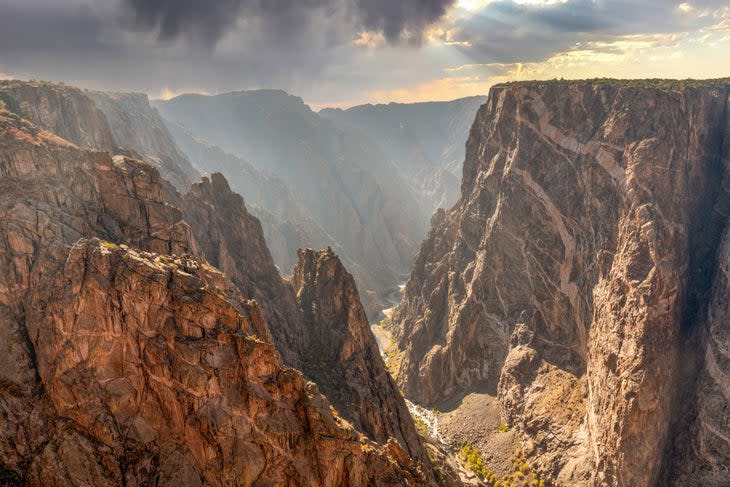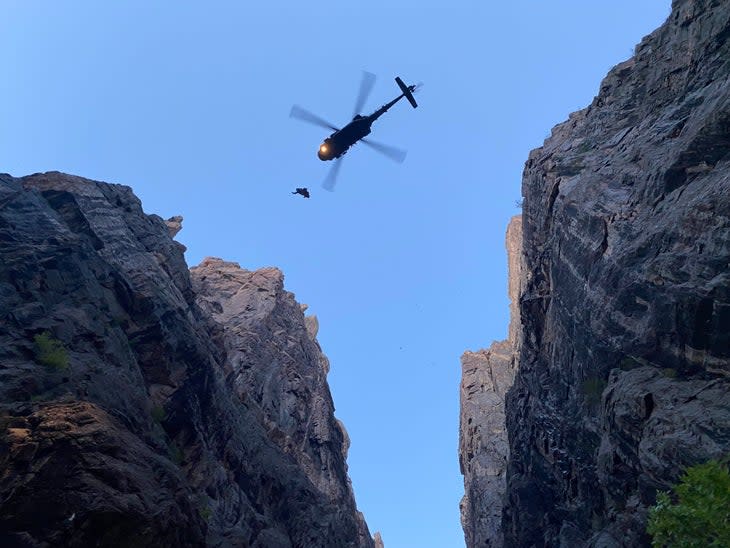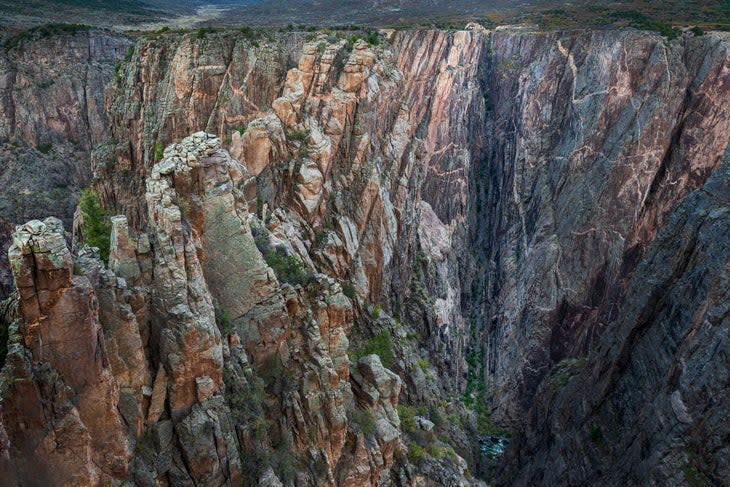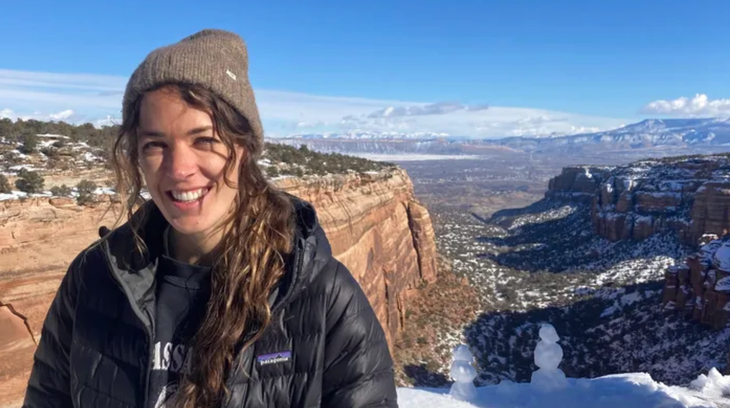A Climber’s Fall Prompted a Dramatic Rescue in this National Park
This article originally appeared on Outside
A 30-year-old woman from Grand Junction, Colorado, is in critical condition after a fall and dramatic rescue which occurred on Monday, September 11, on The Great White Wall, a 1,300 foot climbing route in the Black Canyon of the Gunnison National Park.
Becca (the family asked that we not divulge her last name for the sake of privacy) was about thirty feet up the fourth pitch when her foothold broke. The one piece of protection she had below her ripped from the wall when her rope came taught, and she hit the ledge at the base of the pitch hard. Becca sustained multiple broken bones, a punctured lung, and a severe head injury which left her immediately unconscious.
Becca's partner, Skyeler Congdon, said that she was on terrain well-within her abilities. Becca had recently climbed a much harder rout in the same style in Unaweep Canyon in Western Colorado. "She's a strong and competent climber. It was just one of these unfortunate situations where her hand holds weren't good enough to catch her when the foothold broke."
A Bold and Daring Rescue
Becca's fall occurred at roughly 7:30 A.M. Congdon was torn over what to do when she did not regain consciousness. "You never want to leave an unconscious victim," he said. "I thought about lowering her, but I didn't have any way to protect her spine." Ultimately, he decided to get help as quickly as possible. He secured her to the anchor, rappelled down to the start of the route, and "ran as fast as I could up the gully, back to the ranger station."
When Congdon arrived at the ranger station, he was surprised to find nobody was there. So Congdon got in his car and "hauled ass another 15 minutes to cell reception," where he called 911. After a frustrating run around with Montrose dispatch transferring him to Delta, then Delta transferring him back to Montrose, and Montrose trying to transfer him back again, he "lost his shit and told them 'this girl is going to die, I need rescue support now.'" Montrose relayed the report to Black Canyon district ranger Ryan Rees, who called Congdon, told him to stay put, and that rescuers would soon be on their way.
Rees and District Ranger Ryan Thrush--who took charge of the response as Incident Command--called the park's two paid climbing rangers, Tom Schaefer and Philippe Wheelock, at roughly 11:15. Schaefer was at his home in Crested Butte, Wheelock was out hunting 45 minutes from the nearest road. Both rangers were off duty, but immediately began making their way to the North Rim ranger station, more than two hours of drive and hike time away for each. Schaefer quickly dispatched the SAR team--composed of employees and volunteers from numerous locations in a roughly two hour radius--to respond to the North Rim. Wheelock brought climber and volunteer Charlie Faust with him, and Schaefer was accompanied by flight medic and Senior NPS Volunteer, Mike Kingsbury, who happened to be in Crested Butte and available.

It was 1:20 P.M. when Schaefer arrived at the ranger station. Seven other volunteers were already assembled, including long-time Black Canyon climbing ranger, now SAR volunteer and Black Canyon climbing guidebook author, Vic Zeilman. Thrush had spent the last two hours on the phone with various helicopter operators. None of the park's normal short-haul programs were available, but a Black Hawk helicopter capable of hoist operations from High Altitude Aviation Training Site (HAATS) was, pending weather and various other factors. A successful helicopter evac is never a guarantee, even with a helicopter you are accustomed to working with, so Schaefer also planned a massive 1,300-foot litter raise. Either way, the first order of business was to reach Becca. At that point, she had been alone, seriously injured, and presumably unconscious for close to five hours, and HAATS had communicated they would not fly unless the patient was still alive.
Zeilman and Kingsbury started descending the Long Draw gully--a steep choke filled with loose boulders and scree that drops 1,800 feet in one mile--at 1:45 P.M. Wheelock and Faust arrived about 15 minutes later, and rapidly followed them down to the base of Great White Wall. Zeilman led the first pitch, which Wheelock and Kingsbury followed. Wheelock then linked the second and third pitch (a physically demanding section), just barely making the ledge after a full 210 feet. Wheelock radioed to Schaefer that Becca was unconscious but still had respirations and a pulse, and Schaefer relayed the message to HAATS, who began to prepare for flight. Wheelock then belayed up Kingsbury, who climbed quickly despite the massive amount of medical equipment on his back, and hauled a static line from his harness. Wheelock estimated that, all in all, it had taken approximately one hour for the whole three-person team to climb three pitches and access the ledge by about 3:30 P.M.
Once Kingsbury arrived, he began to administer patient care. Kingsbury, who Wheelock described as "an ace flight medic used to tight spaces," managed to put on a C-Collar, and insert two IV picks--one on each arm--through which he began to pump fluids and life-supporting narcotics. This was made more complicated by the fact that they were on a narrow, sloping ledge full of loose rocks, with other rescuers directly below them, including Zeilman, who was busy ascending Kingsbury's static line to build an anchor and establish another fixed line at the top of pitch two.
It was roughly 4:00 P.M. when HAATS got the message that Becca was alive. Flight time from their base in Eagle would be about 38 minutes, it would take another half hour to put together a flight plan and safety briefing, and the HAATS pilot wanted to be out of the canyon by dark. There was time, but not much of it. A helicopter rescue at that point was far from guaranteed.

So Schaefer--who was manning Ops back on the canyon rim--continued with the contingency plan. He organized two additional teams to assist the Climb Team already in the canyon: the Gully Team, which would descend the Long Draw in order to help transport the patient; and the Rim Team, which would rig the 1,300-foot raise on the wall opposite the climbers--a wall they had never practiced a raise or lower on before. A direct raise above the climbers was not possible due to the ledgy nature of the wall, and incredibly chossy terrain, creating a massive overhead hazard for both Becca and the rescuers below.
Back on the wall, Wheelock and Zeilman had set up a dual-tension two-rope system and began lowering Kingsbury, who descended with Becca (IV ports, C-collar, and all) on his back. They arrived in the gully somewhere between 5:00 and 5:30 P.M. where the Gully Team--consisting entirely of volunteers, with the exception of team-lead Rees--began packaging her for transport. At this point, Nick Wasser--ex-Black Canyon climbing ranger, registered nurse, and SAR volunteer--was being lowered down the 1,300-foot wall. He was one-third of the way down when HAATS called and said the helicopter was inbound. At first HAATS wanted to come in above the rescuers, which Wheelock and others vehemently opposed given the rockfall hazard that would create. Once an alternate flight plan was established to enter the canyon and fly up Long Draw from below the rescuers, Wasser was lowered the rest of the way to the gully, landing about 200 feet above the Gully Team and Becca.
When the Black Hawk arrived it made its way as high up the gully as possible, about 600 feet downhill of the Gully Team. Two flight techs were lowered from the helicopter, which flew off to wait at the North Rim. The flight techs hiked up the gully, and told the Gully Team they would have to bring the patient down 600 feet, and that they had thirty minutes to pull it off. The time was roughly 6:30 P.M.

At this point, there were two options: lower Becca at breakneck speed and run the risk of the helicopter leaving, putting them even further from the Rim Team's raise system; or begin making their way 200 feet up the gully to interface with the Rim Team, and get raised 1,300 feet up the wall. Schaefer estimated the rope raise alone would take about an hour and a half, not including the time to get the litter up to Wasser for the raise. Becca had now been unconscious for 11 hours. Schaefer knew the terrain in the gully was incredibly loose scree, and would be difficult to travel in either direction. From up on the rim, he did not feel he was in the right position to make the call. He asked Wheelock and Rees to do so instead.
Wheelock--a current Rigging for Rescue instructor with more than 25 years of climbing and SAR experience--began to do some mental math. "The lower would require all three of our ropes, which meant we'd have to pass two knots. It would take a minute or two per knot pass. So that would leave us something like 25 minutes to descend 600 feet. I knew it would be tight, but based on my experience, and the experience of the team, I calculated that we could pull it off."
Wheelock knew that the helicopter could bug out and decide to leave at any moment if it got too dark, too windy, if the pilot just didn't like how it felt. But he decided to go down, knowing that if it worked out, it would be the quickest way to get Becca to definitive care. "There were no good options," he said, "just options." He took the three biggest members of the Gully Team and told them "you're going to take this litter, put it on your hip, and you're going to run down this gully as fast as you can, and we'll belay you down and basically all we can do is keep you from going into the river."
Faust and Wheelock put the Gully Team and Becca on a lower system. They raced down the first rope to its end, passed the first knot, raced down the second rope, passed the second knot, and began down the third rope. Finally they were at the pickoff point. The Black Hawk flew in, lowered the hoist, and one of the techs clipped himself and Becca into the cable. They were hauled up into the Black Hawk, which departed for Montrose airport at about 7 P.M., with not a minute to spare.
The Current Situation
From the Montrose airport, Becca was transferred to a CareFlight helicopter, which took her to Saint Mary's hospital in Grand Junction. She was still unconscious, but alive.
Since then, her condition has improved slowly, but continually. She is no longer technically in a coma. She has begun to show signs of consciousness, and the ability to move digits and limbs. In spite of multiple broken bones, her doctors do not think any will require surgery to repair.
As of Monday, September 18, Becca had begun to "respond periodically when asked questions," according to her parents. "For example... she has responded to the nurse to signal two fingers and then three fingers when the nurse showed her that many fingers." She is still on a ventilator, but largely as a precautionary measure in case of any situation that might necessitate an emergency surgery. At this point, the ventilator is providing very little support, and she is breathing mostly on her own.
Becca's parents expressed their profound gratitude to the more than 25 employees and volunteers who participated in the rescue. "We want to thank all the members of the search and rescue team and acknowledge that we know a number of those people risked life and limb for her. Also her climbing partner, Skyeler. He did all the right things, took care of her, secured her, got down and got help. He was a hero, himself." On Sunday, they drove from St. Mary's Hospital to the North Rim ranger station to meet with the SAR team and say thank you in person--a rare and heartfelt gesture that was deeply appreciated by the entire SAR team.

"Becca is a well-known, liked, and respected member of the tight-knit Western Slope climbing community; and a loving, intentional, and generous friend," one friend commented. "Her drive to push self imposed boundaries is contagious, and her eagerness to accept and meet challenges--in climbing and life--is an inspiration." Another friend referred to Becca as "a badass with a huge heart... a person who feels deeply, loves climbing, her partner, her amazing dog, travel, her friends, self-improvement, yoga, and so much more. She is a great climbing partner--smart, safe, and competent. It is unimaginably tragic that this happened."
The family has established a GoFundMe, and is kindly asking for donations to help defray the cost of Becca's mounting medical bills. The GoFundMe page also includes a touching tribute from Becca's partner, Parker, who described her as "a deep, thoughtful and complex woman with a wonderfully multifaceted nature... honest, curious and [someone who] can light up a room with her smile and eyes."
To help support Becca, please visit the GoFundMe here.
A Program in Peril
Climbing rangers Schaefer, Wheelock, and Zeilman all described Monday's rescue as one of the most difficult, complex, and risky of their careers--each of which spans more than a decade. Cumulatively, they have 25 years of SAR experience in the Black Canyon.
"Having the time to train and work with this team and the camaraderie and friendship is what inspires confidence in being able to pull off a rescue like this," said Schaefer. "Everyone played a role. We don't do a ton of rescues like this, but because of how dedicated everyone is--all the years of working together and planning for something like this--we were able to get the job done."
Wheelock agreed that this was a team effort, made possible not only by many years of hard work by all parties involved, but also support from the park's previous administration. Unfortunately, that support has been increasingly absent under the park's new superintendent, Stuart West, who was hired in early 2023, and described himself at an all-department meeting as someone who was "there to trim the fat."
Under West, the climbing rangers and SAR program have undergone a variety of concerning changes. Around mid-August, Schaefer, Wheelock, and the rest of the park staff (including Law Enforcement Officers) were locked out of the North Rim Ranger Station where all EMS and Climbing Patrol equipment had been located for decades. The locks were changed while Wheelock was on his days off, and when he showed up for his next shift, he was unable to get in. Wheelock was then informed that he and Schaefer would need to return their emergency response vehicles to headquarters, remove all their personal effects from the ranger station, and begin traveling to the North Rim in their personal vehicles. At that point he took sick leave, during which he met with West and "begged him to change the locks back so that he and the rest of the staff could access emergency medical equipment." Schaefer made the same urgent request, and a week later, the locks were finally changed back.
But the damage at that point was done. For years, Wheelock, Schaefer, and other rangers had relied upon a functional system that included storing their personal patrol gear, as well as emergency response go bags, at the North Rim Ranger Station. Suddenly, they could no longer rely on that resource, and were forced to figure out a new system on the fly. All of the above added unnecessary stress, anxiety, and confusion to the initial stages of the rescue that occurred on Monday.
"Our morale is dependent on getting support from the administration," Wheelock said. "This isn't fat you're trimming. You're cutting through muscle and hitting bone. We feel incredibly undervalued right now, and are really struggling to maintain a vision of the future that resembles what we saw on Monday--an incredibly diverse, highly skilled group of individuals coming together to solve a really complex and dangerous problem, and succeed. To have that disappear at the expense of policy is a tragedy. Not just for us, but also for the public."
Wheelock and Schaefer agreed that at the rate things are going, it's likely there won't be a climbing ranger program or volunteer SAR team at all at Black Canyon National Park next year. "And I know none of us want that," said Schaefer, "but that's the direction our superintendent and administration has chosen to take. And we're trying really hard to come up with solutions to combat that, because at the end of the day, visitor and rescuer safety is completely dependent on those elements."
While the future of the Black Canyon Climbing Ranger and SAR program is uncertain, what can be said with one hundred percent certainty is that without their expertise and bravery, Becca would now be dead, not recovering in a hospital in Grand Junction. That is a fact. It's not just the climbing rangers who deserve better--it's climbers like Becca, too. Any tax-paying American who wants to visit our national parks deserves better. We all do.
To help support Becca, please visit the GoFundMe here.
For exclusive access to all of our fitness, gear, adventure, and travel stories, plus discounts on trips, events, and gear, sign up for Outside+ today.

